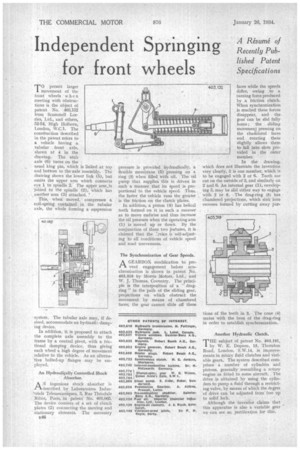Independent Springing for front wheels
Page 56

If you've noticed an error in this article please click here to report it so we can fix it.
TOpermit larger movement of the trout wheels when meeting with obstructions is the object of patent No. 403,132 from Scainmell Lorries, Ltd., and others, 52-54, High Holborn, London, W.C.1. The construction described in the patent refers to. a vehicle having a tubular front axle, shown at 4 in the drawing. The stub axle WO turns on the '
usual king phi, which is linked at top and bottom to the axle assembly. The drawing shows the lower link (5), but omits the upper arm which connects eye 1 to spindle 2. The upper arrn,is joined to the spindle (2), which has another arm (3) attached. • This, when moved, • compresses a coil-spring contained in the tubular axle, the whole forming a suspension
system. The tubular axle may, if desired, accommodate an hydrauli?, damping device.
In addition, it is proposed to attach the complete axle assembly to the frame by a central pivot, with a frictional damping device, thus giving each wheel a high degree of movement .relative to the vehicle. As an altema:tive bolted-up flanges may be employed.
An Hydraulically Controlled Shock • . Absorber.
AN ingenious shock absorber is described by Laboratoires IndusTelernecaniques, 3, Rue Theodule • Ribot, Paris, in patent" No. 401,005. The device consists of a set of clutch plates (2) connecting the moving and stationary elements. The necessary
B46
pressure is provided hydraulically, a flexible membrane (5) pressing on a ring (3) when filled with oil. The oil pump that supplies this is driven in such a manner that its speed is proportional to the vehicle speed. Thus, the faster the vehicle runs the greater is the friction on the clutch plates.
In addition, a piston (4) has helical teeth formed on it in such a manner as to move endwise and thus increase the oil pressure when the operating arm (I) is moved up or down. By the conjunction of these two features, it is claimed that the 7;Ivice is 'self-adjusting to all conditions of vehicle speed and road unevenness.
The Synchronization of Gear Speeds.
A GEARBOX modification to pre-cm. vent engagement before synchronization is shown in patent No. 403,319 by Morris Motors, Ltd., and W. J. Thomas, Coventry. The principle is the interposition of a " dragring " in the path of the sliding gear, projections on which obstruct the movement by means of chamfered faces; the gear cannot slide off these
differ, owing to a turning force produced by a friction clutch. When synchronization is reached these forces disappear, and the gear can be slid fully home; the sliding movement pressing on the charafered faces and rotating theni slightly allows them to fall into slots provided in the outer member.
In the drawing, which does not illustrate the invention very clearly, 3 is one member, which is to be engaged with 2 or 6. Teeth ate cut on the outside of 3, and similarly on 2 and 6. An internal gear (1), enveloping 3, may be slid either way to engage with 2 or 6. The drag-ring (5) has chamfered projections, which sink into recesses formed by cutting away per Another Hydraulic Clutch.
THE subject of patent No. 403,191, by W. E. Dopson, 15, Thornton Road, London, S.W.14, is improvements in rotary fluid clutches and variable gears. The system described comprises a number of cylinders and pistons, generally resembling a rotary engine as fitted to some aircraft. The drive is obtained by using the cylinders to pump a fluid through a restricting valve, by meang of which the degree of drive can be adjusted from free up'
to solid' lock. • Although the inventor claims that this apparatus is also a variable gear — we can see no justificakion for this,




















































































